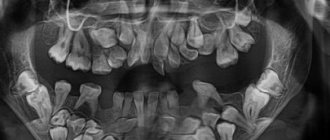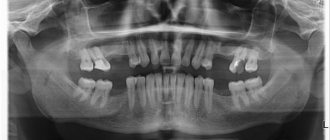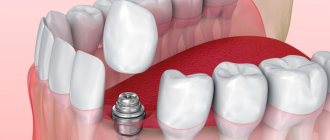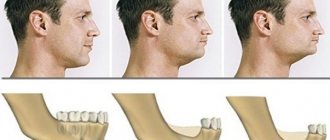Veneers
Ceramic “scales” that are attached to the surface of the teeth after preliminary grinding.
Tabs
Microprostheses made of ceramics.
When working with veneers, artistic restoration of teeth is performed in 3 stages:
- Examination, professional oral hygiene, planning, taking impressions. Modeling future restorations in wax or plastic. At this stage, the doctor and the patient select and adjust the shape and color. Taking high-precision impressions for permanent structures, the impressions are sent to a dental laboratory. Also, at each visit, before fixing permanent restorations, the tooth is processed and closed with a temporary filling.
- Removing the temporary filling. Treatment of the tooth surface. Isolation of dental units from moisture. Drying the surface and fixing the overlay, veneer. Lighting and polishing.
Our clinic uses advanced materials and indirect restoration techniques, which do not always require enamel removal. We use this approach when we detect a diastema, trema, or spaces between teeth in a patient.
The production time for veneers is 7 days.
Service life - 10−15 years.
Aesthetic dental restoration with veneers - advantages and disadvantages
Advantages
- Predictability of the result. Thanks to close cooperation between the doctor, dental technician and patient
- Naturalness. Inlays and onlays are no different from other teeth
- Does not require special care
- Ceramic products prevent the formation of plaque (bacteria cannot cling to a smooth surface)
- They are not afraid of temperature changes, do not darken or wear off over time
Flaws
- Incomplete restoration of chewing functions. We do not recommend eating solid foods
- Relatively high cost (compared to direct restoration)
- Enamel grinding in most cases
Why can't we leave everything as it is?
When a person loses a tooth in the smile area, he usually tries to restore it - but with chewing teeth that are not visible, the situation is different. Many people think that if one chewing tooth is lost, then nothing bad has happened - the rest are in place, which means they can chew.
Each tooth in our jaw carries an important functional, and not just aesthetic, load. If the tooth is not restored, negative consequences will inevitably occur:
- improper distribution of the chewing load will lead to gradual destruction of the teeth next to the defect - after all, they will have to work for themselves and for the lost tooth;
- bone tissue atrophy will occur due to the fact that there is no load during chewing;
- Bite defects will appear - if a tooth has been missing for years, then its row neighbors gradually begin to shift towards the empty space;
- chewing food will not be of sufficient quality, which over the years will lead to the development of problems with the gastrointestinal tract;
- bite defects will negatively affect the functioning of the temporomandibular joint, which will provoke neck pain, headaches, discomfort and pain when opening the mouth or chewing, even insomnia;
- Diction problems will appear.
Examples when only the roots of the teeth in the upper jaw remain
Example 1. Restoration from one root of a front tooth
In this example (presented in full here), the situation was created literally by the patient’s hands. She tried to glue part of the tooth with superglue and, under the influence of dangerous substances contained in the glue, the crown of the tooth became completely unusable.
But the root of the tooth under the crown below remained intact and unharmed.
The length of the healthy part of this tooth root removed all doubts about the question - is it necessary to restore the root? Certainly! - it is possible and necessary. The tooth was restored in 1.5 hours using Cerec technology. And here in the photo is the happy owner of a new restored front tooth:
Example 2. Restoring 3 front teeth, of which only the roots remain
Here is a treatment example where I restored the aesthetics of her smile to a 22-year-old girl. The three front teeth on the upper jaw were completely destroyed. From the upper teeth 1.2, 1.1, 2.1 only
the roots
:
These three teeth were actually an aesthetically unsightly frame made from old fillings. Now we will not analyze the whole case in detail, I would like to draw your attention to the following points:
- the shape of the roots of the teeth and their condition made it possible to restore them
- There was no talk at all about any amputation - removal of the roots of the teeth of the upper jaw and implantation.
Our patient's smile was designed in a computer program:
So, in the photo below you see a general set for restoring our patient’s dentition, and among the modules there are 3 with a crown and a root.
The roots of the upper front teeth were quickly and, most importantly, effectively restored:
and our patient underwent a beautiful transformation and became the owner of a sweet and chic smile:
This is the enormous potential and aesthetic power of healthy tooth roots! Don't rush to delete them)
Example 3. Complete restoration of the smile zone on the front teeth of the upper jaw
This example is actually very popular on the Internet, since the patient is a TV presenter, and as a result of the treatment she found her new smile. Which is extremely important for her profession. I describe the detailed clinical case itself in another article, but here I would like to note the main points related specifically to the restoration of the roots of the front teeth with crowns.
In the picture below we have removed composite restorations and carious lesions. only the roots remain of the two front incisor teeth.
:
Crowns and “crown + root” modules were prepared in the laboratory:
After installation, the smile began to shine with bright colors:
You can see the entire chronology of our patient’s treatment in one large picture, step by step:
But how to place a tooth if there is no root?
The main goals of prosthetics are to return the patient to the ability to chew food normally, restore the aesthetics of a smile, and prevent further tooth decay due to chewing overload. Here are 3 main ways to insert a tooth:
- removable prosthetics
- making a prosthesis from nylon, acrylic, silicone, Acry Free material; - bridge prosthetics
- the classic technique involves grinding two adjacent teeth with a defect, which will be used as supports for a prosthesis that replaces a lost tooth. It is also possible to install a bridge on implants; - installation of an implant
followed by loading with a crown.
Sometimes patients ask if it is possible to grow a tooth in any way without a prosthesis? Alas, no - if a tooth is removed or lost along with the root, then there is literally nothing to build up. The methods of tooth extension, which we also talked about, are effective only in cases where there is a root and some volume of the crown has survived.
Examples of canine restoration when only the root remains of the tooth
Example 4. The pin in the root of the lower tooth was removed, and the canine itself was restored
In this clinical case, I was restoring the lower canine, and the task was to save the root of the tooth and restore the coronal part of the canine, which was almost destroyed by caries. The anterior wall of the lower canine was made in the form of a filling, and it fell apart from the cutting edge.
As you can see in the photo, an anchor pin was installed inside the tooth - this is a pin that is screwed into the canal to strengthen the tooth. The tooth under the filling and the root of the lower canine were affected by caries. When the carious tissue was removed, only the root and a small part of the wall
:
You and I remember the main topic of our article, which tells us the following - if the tooth root remains, it can be completely restored. And this is not the first time that the unique Cerec technology has come to our aid. Using it and digital scanning, we restored the missing tooth module, which also included the root part:
Next, we restore the lower front tooth using a CEREC inlay and get an excellent result - the lower canine is completely restored:
Example 5. The root of the tooth under the crown of the upper canine has not rotted, and therefore the tooth is 100% restored
In this case, there was a total restoration of the dentition (veneers and crowns) with the replacement of worn-out crowns on the front teeth. One of the upper canines under the crown was seriously affected by caries, but its root was practically healthy - only a small part of the tooth root was damaged, see the following photo:
The missing “crown + root” module and new crowns were manufactured in a laboratory. In general, everything is in a smile, it looks just great:
And the owner of a new beautiful smile herself cannot hide her admiration:
All the main tasks in this total work were successfully solved, but the main thing you should pay attention to is that we managed to save the tooth root here too.
Removable dentures
For centuries, dentists have been solving the problem: if there is no root, how to make a tooth? The first option, which has been around for thousands of years, is removable dentures. They were found during excavations of Egyptian tombs and in the territory of the Mayan Indians, so this is one of the most ancient methods of restoring teeth.
What are its advantages? Firstly, it is fast - making a prosthesis takes from 3 to 7 days, depending on the complexity of the work; secondly, it is inexpensive compared to bridges or implants. Modern materials for removable dentures make it possible to create structures similar to natural teeth, but they still have disadvantages:
- service life even with careful care is about 5–7 years;
- constant risk of prosthesis falling out and the need for additional fixation;
- the prosthesis does not stop bone atrophy;
- does not allow the chewing load to be evenly distributed;
- sometimes causes diction defects;
- there is a risk of allergies to acrylic, nylon, silicone and other materials.
Removable prosthetics are now being used if there are absolute contraindications to the installation of bridges or implants, or as a temporary measure while the patient waits for a permanent prosthesis to be made.
Light filling on a pin – what are the advantages of the method?
A post filling is considered a reliable replacement material when a dentist is restoring a fractured unit. A titanium or fiberglass pin is inserted into the root canal, after which the coronal part is restored with a composite material. Among the disadvantages of the method is the potential risk of root fracture, since the pin fails under pressure, as well as shrinkage of the filling and the development of secondary caries under it.
Unfortunately, teeth restored in this way do not last forever. After 3–5 years, the dentist will have to change the filling or, due to global destruction of the crown, perform prosthetics/implantation.
Bridges
The good old classic that dentists offer when they see that a root is missing. Bridges do not need to be removed from your mouth every day to be cleaned, unlike removable dentures, they will last 10-12 years with proper care and are much better at restoring chewing function. Modern materials are quite effective at restoring a beautiful appearance to a smile. The price and production time of such a prosthesis is higher than that of a removable prosthesis, but lower than that of an implant.
What are the disadvantages of this technique?
- With classic prosthetics relying on your own teeth, due to the uneven distribution of the load during chewing, the supporting teeth under the bridge gradually begin to collapse.
- Bone atrophy also does not stop.
- The denture requires special cleaning products - pipe cleaners, brushes, etc., otherwise food debris and plaque will accumulate under it.
- The implant-based method is not always possible - if one tooth or two in a row is lost, the doctor will not remove adjacent healthy teeth in order to put implants in their place.
Should I remove the decayed tooth or treat it?
With the development of modern dentistry, many people look differently at the process of dental treatment, but there are still frequent cases when a person does not go for dental treatment solely out of fear, remembering the negative personal experience of dental treatment 20-30 years ago.
And there are situations in life, everyone has their own and they are all understandable, when it is not possible to do dental treatment in a timely manner. And the inflammatory process from caries develops into deeper damage to the tooth tissue. Often the situation reaches the point where a badly damaged tooth remains in the mouth. And at this moment a person is often inclined to think that the destructive process has already gone so far that he sees no other solution to the problem other than contacting a professional dentistry center and removing the affected tooth.
We advise you not to draw independent conclusions on this matter.
What should be done in this situation?
- Make an appointment with your dentist. Moreover, you need to make an appointment not with a surgeon, but with a dental therapist and an orthopedic dentist, only the two of them decide on the possibility or impossibility of saving the tooth.
- The specialist will definitely do a computed tomography scan in the area of this tooth or suggest, if necessary, an orthopantomogram.
- Based on the examination and modern X-ray diagnostic methods, the doctor will tell you whether it is possible to cure and restore this tooth, and explain all possible restoration options.
There are often ambiguous situations when none of the doctors can guarantee with one hundred percent certainty that the tooth can be saved. A lot depends on the body’s ability to cope with inflammatory processes. When you are offered a probable chance that the tooth will be saved or that your body will not cope and the tooth will still have to be removed, despite the money invested and the time spent, the choice will always be yours. How ready are you?
There are cases when doctors give rather pessimistic forecasts for saving a tooth, but the patient is ready to try treatment, the body reacts very favorably, the cyst goes away and the tooth serves well for many years. And it happens the other way around: the forecasts are very promising, but during the treatment process some kind of failure may occur in the body and for a long time no positive dynamics are observed, or even vice versa, the affected area progresses.
In what cases do teeth definitely need to be removed:
- The crown part of the tooth has chipped deep under the gum; such a tooth can no longer be restored.
- The x-ray shows that there is resorption of bone tissue between the roots of the tooth; treatment of such a tooth is pointless, because the inflammatory process has already begun to destroy the bone and in order to stop this process of inflammation, there is only one way out - tooth extraction.
- There are large cystic formations at the apex of the root(s).
- If the jaw is severely injured, it may be necessary to remove the tooth(s).
- If a tooth is fractured (if it occurs longitudinally, its restoration becomes impossible)
- When there is severe tooth mobility.
- Eighth teeth (“wisdom teeth”), also known as third molars. They usually grow in the wrong position, put pressure on the dentition, cause crowding and put strong pressure on the adjacent seventh teeth.
- Almost always, a tooth is removed that was previously subjected to canal treatment and during the previous treatment a perforation of the root canal occurred.
- A chronic inflammatory process has already formed in the bone tissue, which cannot be treated.
- Sometimes, during orthodontic treatment, when the jaw has already formed, there is a lot of crowding of the teeth, and there is not enough room for the teeth to move to form a correct bite. The teeth that need to be removed in this case are determined by the orthodontist after diagnosis and calculations.
When you need qualified advice and help from a dentist, come to us for a consultation. You will receive answers to absolutely all questions regarding the health of your teeth. Regardless of how long you have not sought treatment from a dentist and what condition your teeth are in, you will not see reproachful glances, but will receive high-quality treatment from our doctors. As a rule, we always select a time for consultation when all the necessary specialists can spare time for a conversation with you.
Even severely damaged teeth often have a chance of recovery; consult a doctor. And it’s better to come late than completely late or never.
Dental implantation
A provocative question: is it possible to put a crown on the root of a tooth? Yes, if this root is an artificial implant made of titanium alloy or even zirconium. Installing an implant solves almost all problems with tooth loss:
- stops bone atrophy;
- completely restores the natural distribution of chewing load;
- no damage to neighboring teeth;
- excellent aesthetic result;
- implant service life - from 25–30 years to lifelong;
- a large number of possible options for creating crowns - ceramics, metal-ceramics, solid zirconium or zirconium with ceramic lining;
- ease of care, no different from the hygiene of natural teeth.
Why do tooth remains appear in the gums?
There are many reasons for this phenomenon:
- Perhaps the tooth has completely crumbled, but the root remains.
- The crown received a strong blow and a fracture occurred.
- An incomplete tooth extraction was performed. The remaining fragments cause inflammatory processes in the soft tissues, causing pain.
- Units with the neurovascular bundle removed are often destroyed. The so-called “dead teeth”. The nutrition of their walls is disrupted, the shell becomes fragile and, due to incorrect loading or due to increased fragility, the natural walls break off “at the root.”
If the process has already started, then urgent treatment of the tooth root is necessary. Otherwise, the remains of the unit will have to be removed to avoid infection of adjacent teeth and surrounding tissues.
The situation cannot be ignored: tooth fragments may not bother you at first, but then turn into a serious problem. When trouble occurs, immediately contact the dental clinic to promptly select treatment and find ways to restore the tooth.
What to choose?
What to install if there is no root - a removable denture, a bridge or an implant? The dentist will select prosthetic options based on the condition of the oral cavity and the presence of relative or absolute contraindications. However, today doctors most often offer implant prosthetics. It has only two disadvantages compared to other types - a higher price and a longer period of prosthetics with several stages. However, this is compensated by excellent, long-term and predictable results. In addition, implantation technologies are constantly being improved; there are already techniques and implants that can significantly reduce the time of prosthetics.
Features of Cerec technology
Cerec root inserts and crowns are made from metal-free materials - it can be ceramic or zirconium dioxide. They can be installed even for allergy sufferers without fear. This technology has completely changed traditional approaches to dentistry.
Now the restoration process is comfortable and takes a minimum of time. In my clinic, the procedure is carried out in several stages.
I would also like to note that only one anesthesia is required and there are practically no errors when creating new teeth. Stages:
- An intraoral scanner determines the boundaries of the damage. This is especially important when only the roots of the front teeth or molars remain. The remaining tissues, antagonist teeth, and closed rows are scanned.
- The information is transferred to a computer, where all the images are combined into an image.
- The program creates a three-dimensional model of the remaining tooth, all defects are clearly visible. Then models of the inlay and crown are created that perfectly replicate the anatomical features of the tooth. Dimensions and shape are calculated accurately. It is determined what kind of restoration is needed.
- The design is made from blanks on a milling module. The elements are being tried on. In rare cases, correction is required. Shade discrepancies or other issues that displease the patient can be easily corrected within a few minutes.
- The completed root inlay fits hermetically to the remaining parts of the tooth, is securely fixed and exactly matches the shape.
Thus, it is possible to quickly restore units if only the roots of the teeth of the lower or upper jaw remain.
Photopolymer compositions: features and indications for installation
Such fillings for dental treatment are cured under the influence of light waves, in most cases in the ultraviolet spectrum. They are suitable for installation on the front and lateral teeth, have good adhesion to natural tissue, have a long service life, and allow you to choose a shade that is as close as possible to the color of the dentition.
Light-curing fillings are placed for:
- Protection of damaged outer (enamel) and inner (dentin) layers of the tooth.
- Restoration of medium and large cavities.
- Elimination of too wide interdental gaps.
- Correction of tooth shape.
The photopolymer composition is not recommended if the patient has severely inflamed gums, allergies to components or involuntary grinding of teeth.
Materials for restoration and restoration of teeth
Zubastik dentistry uses modern photopolymer materials for dental restoration. Light-curing fillings restore the coronal part, even if it is destroyed by more than 50%.
The line of imported composites contains all colors of natural enamel, which provides a natural look after restoration. Photopolymer materials for dental restoration are especially strong, non-toxic, and durable.
Veneers are recommended for the correction of defects in the anterior units. Thin non-removable linings are made individually using high-precision equipment. They are fixed on the outside of the tooth.
If necessary, crowns made of ceramics, metal-ceramics, and metal-plastic are used. An alternative to crowns are special ceramic inlays, which are used to restore part of a tooth. Such a microprosthesis, made with high anatomical precision, will last a long time and look natural.











